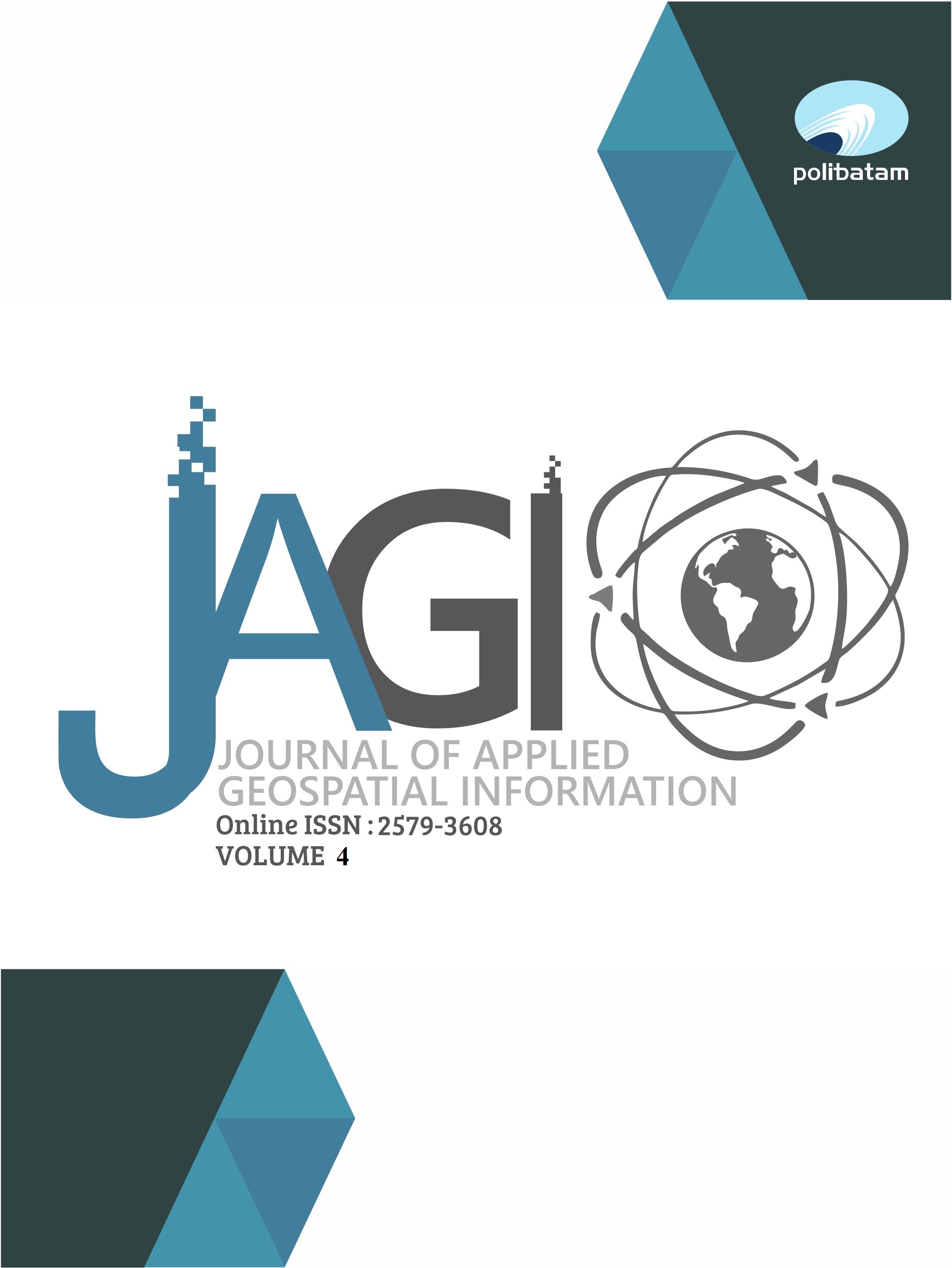Mapping Archaeological Site of Keraton Pleret Using Aerial Photograph
DOI:
https://doi.org/10.30871/jagi.v4i1.1994Keywords:
Archaeological site, Keraton Pleret, Orthophoto, Mapping, LanduseAbstract
As a cultural heritage, Site of Keraton (Palace) Pleret becomes an essential relic in Javanese history and culture to preserve and deliver ancient information for the next generation sustainably. On the other hand, this preservation is dealing with quite rapid built-up area development. Mapping can be a significant effort as primary data in cultural preservation management. This study aims to make a detailed site map of the Keraton Pleret and identify the existing land use in each site component. Through remote sensing data interpretation and analysis, identification and mapping of archaeological sites done by matching previous archaeological documents, field conditions, digital orthophoto from aerial photography, and digital topographic data (digital surface models, DSM). Site components were identified firstly by matching the existence of the street network and river from a topographic map with orthophoto to obtain site orientation based on artificial infrastructure and existing natural features. It was followed by matching between Keraton Pleret blueprint document, previous archaeological information, and orthophoto to identify and locate each site component. Existing land use information obtained by orthophoto interpretation. Data analysis shows the compatibility between spatial data used in this research and previous documents to identify components and result in Keraton Pleret site map. At present, most of the Keraton Pleret site area has been converted to buildings and paddy fields, strengthen the need for archaeological sites management which alongside community activities.
Downloads
References
Adrisijanti, I., (2000). Arkeologi Perkotaan Mataram Islam [Urban Archeology of Islamic Mataram]. Yogyakarta: Jendela.
Alfah and Priswanto, H. (2012). Benteng Kraton Pleret: Data Historis dan Data Arkeologi [Keraton Pletet Fortres: Historical Data and Archaeological Data]. Jurnal Berkala Arkeologi, Vol.32 Edition No.2/November 2012.
Badan Informasi Geospasial. (2014). Peraturan Kepala badan Informasi Geospasial (Perka BIG) No. 6 tahun 2018 tentang Pedoman Teknis Ketelitian Peta Dasar [Regulation of Geospatial Information Agency's head No. 6/2018 about Technical Guide in Basic Maps Accuracy]. Bogor: Badan Informasi Geospasial.
De Graaf, H. J. (1987). Disintregasi Mataram Dibawah Mangkurat I [Mataram's Disintegration Under Relign of Mangkurat I], translated edition in Indonesian. Jakarta: Pustaka Grafiti Press.
Dinas Kebudayaan D.I.Yogyakarta. (2014). Menelusuri Jejak Kejayaan Kerajaan Mataram Islam di Pleret [Investigate the Triumph of the Islamic Mataram Kingdom in Pleret]. Video, No. 6071/DVD/13/PA/12.2019/2014, released 5 December 2014.
Hadjimitsis, D.G., Agapiou, A., Themistocleous, K., Alexakis, D.D., & Sarris, A. (2013). Remote Sensing for Archaeological Applications: Management, Documentation and Monitoring. In: Hadjimitsis, D. et al. (Eds.), Remote Sensing of Enviromnet: Integrated Approaches. IntechOpen.
Handayani, W., Ayuningtyas, E.A., Setiawan, B.A., Argadyanto, B. (2017). Unmanned Aerial Vehicle (UAV) Data Acquisition for Archaeological Site Identification and Mapping. IOP Conference Series: Earth and Environmental Science 98 (1), 012017.
Kompas. (2010). Peninggalan Sejarah: Keraton yang Hilang [Historical Heritage: The Lost Palace]. Majalah Arkeologi Indonesia [Indonesia Archaeology Magazine] August, 26, 2010.
Rosaji, S.C.R., Handayani. W., Nurteisa, Y.T., Suharyadi., R., Widartono, B.S. (2013). Aerial/Terrestrial Videography: Alternatif Teknologi Penginderaan Jauh untuk Survey dan Akuisisi data Spatial [Aerial/Terrestrial Videography: An Alternative Remote Sensing Technology for Surveying and Spatial Data Acquisition]. Proceeding of Simposium Nasional Sains Geoinformasi III, ISBN 978-979-98521-4-4.
Rosidi, M., Darmawan, A., Rahmawati, K. (2013). Identifikasi Kawasan Cagar Budaya Situs Kerajaan Islam Mataram di Pleret, Bantul dengan Pendekatan Sistem Informasi Geografis [Identification of the Cultural Heritage Site of the Mataram Islamic Kingdom in Pleret, Bantul using Geographic Information System Approach]. Jurnal Konservasi Cagar Budaya Borobudur, Volume 7 No. 2, December 2013, pp 18-24.
Traviglia, A., Torsello, A. (2017). Landscape Pattern Detection in Archaeological Remote Sensing. Geosciences 2017, 7, 128; doi:10.3390/geosciences7040128.
Wardani, L.K., Soedarsono, R.M., Haryono, T., Suryo, D. (2013). City Heritage of Mataram Islamic Kingdom in Indonesia (Case Study of Yogyakarta Palace). The International Journal of Social Sciences Vol.9 No.1, ISSN 2305-4557.
Downloads
Published
Issue
Section
License
Copyright (c) 2020 Journal of Applied Geospatial Information

This work is licensed under a Creative Commons Attribution-NonCommercial-NoDerivatives 4.0 International License.
Copyright @2023. This is an open-access article distributed under the terms of the Creative Commons Attribution-ShareAlike 4.0 International License which permits unrestricted use, distribution, and reproduction in any medium. Copyrights of all materials published in JAGI are freely available without charge to users or / institution. Users are allowed to read, download, copy, distribute, search, or link to full-text articles in this journal without asking by giving appropriate credit, provide a link to the license, and indicate if changes were made. All of the remix, transform, or build upon the material must distribute the contributions under the same license as the original.









